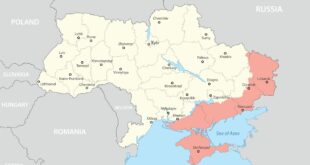Emanuela Gillard
Ukraine has a very narrow window to turn the momentum of the war in its favor. Even then, the Russians are still holding most of the cards.
In May 2022, just three months into the Russia-Ukraine War, I wrote a three-part series in which I identified the military strategy that would give Ukraine the best chance of seeking some sort of tactical success over Russia. It wouldn’t have guaranteed success, I warned, but it was a viable path. As it turned out, Ukraine did virtually none of what I recommended while—ironically—Russia successfully employed several key elements of the path I laid out.
Now, as we approach the two-and-a-half-year mark of the war, and Ukraine is being pushed back on all fronts, I am going to reprise my effort and lay out a realistic but tough path by which Ukraine might yet steal some military success from Russia.
I will warn from the outset that there is no path, however well-resourced, by which Ukraine can inflict an outright military defeat on Russia in the foreseeable future. Russia is too big, too well-resourced, and too well-manned for Ukraine to beat. Yet, if handled deftly, sometimes even tactical defeats by a weaker opponent can be leveraged into strategic success. The following plan represents such an opportunity.
The Russian Center of Gravity
Russia is a behemoth that has many strengths: massive quantities of natural resources, several vital allies who can provide war material, a large and expanding military industrial base, and more than three times as many men of military age as Ukraine. One of the biggest advantages they have may be a high tolerance for sacrifice and suffering. Historically speaking, Russia has sustained horrific rates of casualties throughout multiple wars and still maintained public support or acquiescence. But that doesn’t mean Russia doesn’t have weaknesses.
In military parlance, “center of gravity” is a term that represents the “characteristic, capability, or location from which enemy and friendly forces derive their freedom of action, physical strength, or will to fight.” Russia’s center of gravity rests on twin pillars: its ability to physically wage war (manpower, armaments, ammunition, and industrial capacity) for an extended period and the political support of its population.
Without both, Putin cannot fight or win a war. To wrest any strategic success from Russia, Ukraine will have to knock Russia’s center of gravity off balance enough to force Putin into accepting a less-than-desirable outcome. That’s going to be enormously difficult.
Russia’s overriding strategic objective is to reduce the conventional threat on its western border to a manageable level. They appear convinced that NATO on its border in Ukraine represents an “existential threat” and are willing to pay whatever financial or political price they must to achieve it.
At present, Putin clearly believes Russia is in the driver’s seat and can achieve its political objectives with the military and financial resources it possesses. Ukraine must change that calculation. To ascertain whether that is a valid possibility, however, it is necessary to consider the capacity of Ukraine and its Western supporters to wage and win such a battle.
Ukrainian Center of Gravity & Capacity
Ukraine’s center of gravity is essentially the same. President Volodymyr Zelensky must simultaneously sustain the ability to wage war over time, domestic political support, and international economic, diplomatic, and military assistance. Without any one of these components (especially the third), Ukraine cannot win.
Russia has a wealth of natural resources throughout its country and the domestic industrial capacity to sustain itself almost indefinitely in a war. Ukraine has severe limitations on its supply of natural resources and a mere fraction of Russia’s domestic production capacity. Without massive and sustained material and diplomatic support from the rest of the world, Ukraine cannot wage a long-term battle of attrition. Even with that external support, Kyiv may not be able to win because of its single most important vulnerability: manpower.
Military manpower doesn’t simply mean how many people a country can get into uniforms but how many trained professionals it can mobilize into organized and effective combat units. In a recent Royal United Services Institute study, author Alex Vershinin highlights something few non-veterans understand. The idea “that civilians can be given three-month training courses, sergeant’s chevrons and then expected to perform in the same manner as a seven-year veteran,” Vershinin writes, “is a recipe for disaster. Only time can generate leaders capable of executing NATO doctrine, and time is one thing that the massive demands of attritional war do not give.”
Yet, as The Washington Post recently reported, Ukraine has an acute shortage of new recruits, and those it does get are woefully undertrained. The second leg is also teetering, with Zelensky’s support declining precipitously both at home and among Western supporters. International aid, in spite of recent infusions, is running up against Russia’s strategy of attrition. The window of opportunity for Kyiv to reverse this situation is closing rapidly. Bold, decisive actions are necessary—and quickly—if Ukraine will ever have a chance to achieve success.
Defining Ukrainian Success
It is crucial, however, to define what “success” is even achievable at this point. As noted at the outset, an outright military victory for Kyiv is presently as close to zero as any human endeavor could be. Russia has too much power (and a nuclear trump card) that cannot be overcome, given the existing circumstances. The very narrow path that does exist for Ukraine is to extract such a high enough cost on Russia that Putin calculates it is in his interest to settle for less than his maximalist objectives.
Putin laid out his minimal requirements on June 14 when he said to end the war, Ukraine must surrender the four provinces he illegally annexed in 2022, withdraw all Ukrainian troops from those territories, and adopt a “neutral, nonaligned, nonnuclear status.” Zelensky considered this list of demands—correctly—as “an ultimatum” to surrender. How, then, could Ukraine avoid this undesirable outcome, and what can Zelensky produce with the given imbalance in forces?
Without major changes in Western and Ukrainian war objectives, Putin’s “ultimatum” has a disturbingly high possibility of coming to pass. Ukraine’s most realistic hope is to seek to hold on to all the territories it currently has, not surrender any more land, and negotiate an end to hostilities. But we must acknowledge that it may already be too late to expect even that limited outcome.
The Roadmap to Ukrainian Success
The U.S. Congress passed a $61 billion aid package to Ukraine last April, but the details of what that package included have been slow in coming. The United States announced a $6 billion package in April and another of $2.3 billion last week, but both of those include primarily ammunition, not new armored vehicles. Crucially, however, the majority of all the produce of those deals will not materialize for years, owing to the need to build additional capacity and execute new contracts. Ukraine must then try to succeed with what it has on hand or might get in the coming months.
Before the consideration of the military component of this objective, however, we must identify the specific political objective. Ukraine will first have to communicate to Russia the intent to find a negotiated end to the war. Their negotiators should communicate that Putin’s maximalist demands of June 14 are unacceptable and instead issue the counter of freezing the conflict on its current lines while agreeing to settle the matter of sovereignty over the four regions five years after the end of hostilities, using international mediation.
To achieve even this limited objective outcome, Ukraine will have to successfully mobilize an additional 300,000 troops in the next few months, receive at least a half million artillery shells, seven more Patriot air defense systems, several hundred additional armored vehicles of various types, and tens of thousands more drones. This new combat power would then need to bolster all the defensive lines along the front so that the cost for Putin to capture the remaining provinces is higher than he would gain from negotiations, compelling him to settle for the current line of hostilities.
High Cost, Low Reward
The cost to Ukraine would be very high in personnel to accomplish even this very modest outcome, and I assess there is no more than a fifty-fifty chance Kyiv would pull it off. The Western alliance would have to pull out all the stops to infuse Ukraine with amounts of ammunition beyond what they are currently contemplating and commit large numbers of combat vehicles currently not on the table.
Yet without Ukraine massively increasing its mobilized targets and NATO providing far more than it currently offers, even this limited objective has little chance of success. There is a much higher probability that NATO will satisfy itself with many big speeches and promises of future funding but do little to increase immediate production. That being the case, Ukraine would be far better served by changing its objectives. This would entail a policy that few Westerners and none of Zelensky’s administration want to contemplate: an immediate ceasefire along the lines of what Hungarian Prime Minister Viktor Orban has suggested and a negotiated settlement on the best terms possible.
 Geostrategic Media Political Commentary, Analysis, Security, Defense
Geostrategic Media Political Commentary, Analysis, Security, Defense





